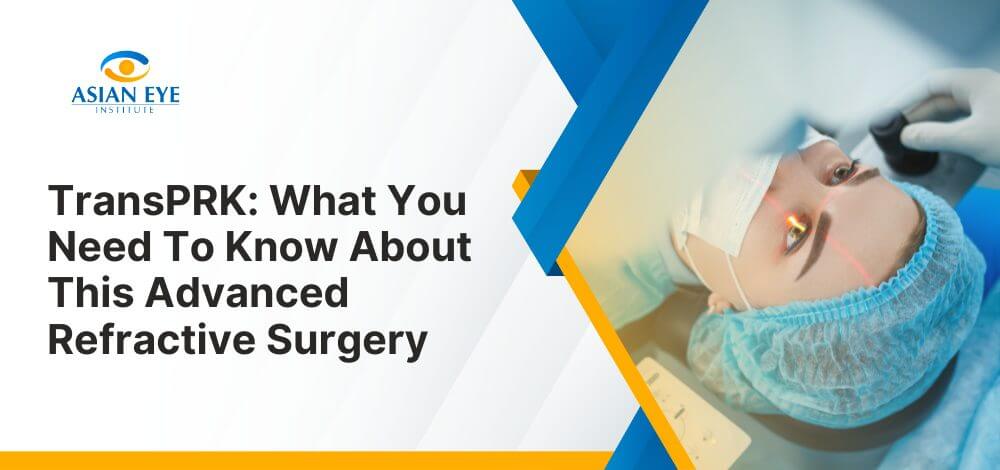
Introduction
Without a doubt, having a clear vision is an essential aspect of a person’s daily life since it allows them to properly see and navigate the world around them. This is why people with refractive errors, like astigmatism, farsightedness (hyperopia), and nearsightedness (myopia), sometimes encounter challenges when performing day-to-day activities.
Traditional vision correction methods, like wearing glasses and contact lenses, can help. However, they can also be restrictive. Luckily, there are modern ways available today that can help people with refractive errors correct their vision. Advancements in medical technology paved the way for procedures like transepithelial photorefractive keratectomy (TransPRK) surgery.
Asian Eye Institute is among the eye care facilities that can perform TransPRK surgery in the Philippines. We have the capacity to provide you with a high level of treatment thanks to our state-of-the-art equipment and skilled doctors. However, if you want to be more informed about the procedure first, reading this article can help. We compiled here all the necessary information you need to know about TransPRK surgery.
LASIK vs. TransPRK
- Laser in-situ keratomileusis, more popularly known as LASIK, is a popular procedure that people can get to correct their refractive error. Learning about both TransPRK and LASIK is crucial for those who are looking for ways to manage their astigmatism, hyperopia, and myopia. Here is how both procedures differ from each other:
- (Insert bulleted list here)
- Corneal Treatment – LASIK involves creating a thin flap in the cornea to access the tissue underneath it. Once the cornea is reshaped, the flap will be put back in its place. In TransPRK, the laser is used to remove the epithelium (the outer layer of the cornea) and reshape the cornea. The ablated surface will regenerate itself after a few days.
- Possible Restrictions – TransPRK can be done for people with thin corneas and chonic dry eyes. However, these individuals might not be pass a LASIK screening.
- Surgical Pain – Both procedures are painless since the patient will be administered anesthesia prior to the surgery.
- Recovery Time – LASIK has a faster recovery time compared to TransPRK. However, patients of both procedures are advised to follow their doctor’s post-operative care instructions to avoid complications.
- Costs of the Procedure – The cost of TransPRK and LASIK in the Philippines depends on plenty of factors. It is best to get the price range of the procedure directly from your preferred eye clinic.
What Happens During TransPRK Surgery?
Prior to surgery, your doctor will perform the necessary tests to determine if you are eligible to undergo the procedure. If there are no problems with your eyes, you will be scheduled for the operation at a time and day convenient for you and your doctor.
During the procedure, your epithelium will be removed using an excimer laser. This gives the doctor access to the inner parts of your cornea, which will then be reshaped with another type of laser. Once this is done, a soft contact lens will be used to temporarily replace the ablated epithelium while it is healing.
The epithelium typically regenerates in less than a week. During this time, the patient is advised to use the prescribed eye drops and avoid exposure to direct sunlight. Once the epithelium is fully healed, the soft contact lenses will then be removed by the doctor. Your doctor will also be the one to tell you if the lenses can already be removed.
TransPRK surgery takes just about five minutes per eye, depending on several factors. It is an outpatient procedure, so the patient can go home on the same day as long as they have someone to accompany them.
Possible Side Effects of TransPRK
The surgery is generally safe, but patients might experience some side effects, such as:
- Dry Eyes – It is pretty common for TransPRK patients to experience dry eyes while they are recovering from the procedure. This can be remedied by using lubricating eye drops prescribed by the surgeon.
- Haze – Also known as corneal haze, this refers to the cloudy or seemingly opaque appearance of the cornea after the surgery, and it often causes blurry vision. This can happen to TransPRK patients if their epithelium does not heal properly, and patients who experience this side effect after the procedure are advised to consult their doctor right away.
- Night Vision Problems – Some patients also report seeing glares and halos at night after getting TransPRK surgery. There are also others who have difficulty seeing in low light. All of these night vision problems typically go away in a few months once the patient is fully recovered.
Speak With a TransPRK Specialist Today
Before deciding to get TransPRK surgery in the Philippines, it is crucial for you to speak with specialists who can inform you more about the procedure. You can schedule a consultation with our ophthalmologists here at Asian Eye Institute. Rest assured that our team of experts all have the knowledge, skills, and experience to help you arrive at a better decision about whether or not you should undergo TransPRK eye surgery.
To schedule a consultation, all you have to do is reach out to us through our online channels. You can fill out this form on our website with the necessary details and submit it virtually. Remember to wait for the confirmation of your schedule, which will be sent to you via email within a few business days.
Alternatively, you can call your preferred branch to visit and speak directly with our staff members. Trust that they will help you find the right schedule and doctor based on your available time.
Conclusion
TransPRK surgery can correct the vision of patients with refractive errors. It is an advanced procedure that involves the use of laser beams to reshape the cornea and help manage nearsightedness, farsightedness, and astigmatism. Many people undergo this procedure to have better eyesight and possibly improve their day-to-day lives.
However, like any other medical procedure, you need to consult a specialist before getting TransPRK surgery in the Philippines. An ophthalmologist can walk you through the entire process and inform you about possible side effects of the procedure. They can also perform the necessary exams to ensure that you are an eligible candidate.
Asian Eye Institute is here to help you if you are looking for TransPRK specialists. If you have questions about the procedure, you can ask our team of experts directly by scheduling a consultation with them. Use our online channels or call our hotlines today to book an appointment with an Asian Eye doctor today!






